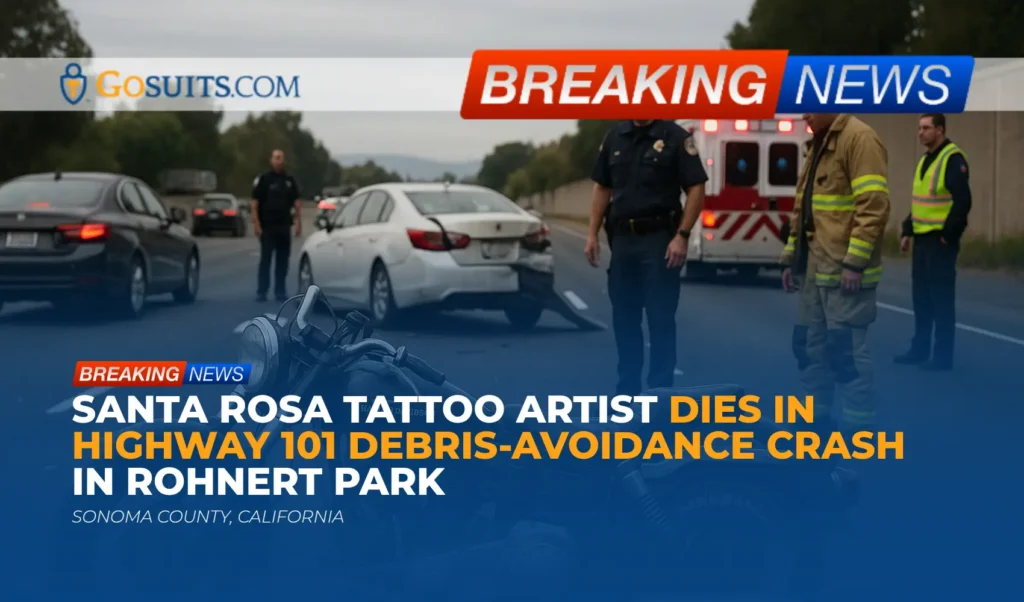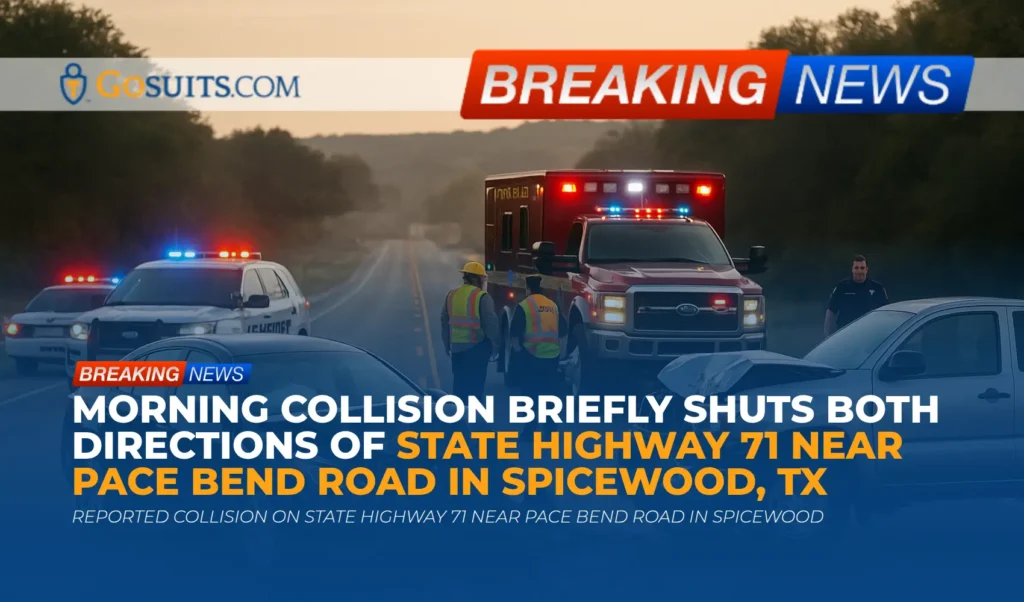- Overview of the EN 10th Street collision in Abilene
- What is known so far
- Why left-turn collisions are especially dangerous for motorcyclists
- Key safety and legal duties at Texas intersections
- Steps to consider in the first days after a fatal roadway crash
- How to obtain official records and documents
- Preserving evidence from the scene and vehicles
- Potential civil liability and avenues for recovery
- Insurance considerations and common pitfalls
- Wrongful death and survival claims in Texas
- Time limits and notice requirements
- Community and public safety considerations
- Commentary from Gosuits Abilene, Texas Personal Injury Attorney
- Why timely action matters now
Overview of the EN 10th Street collision in Abilene
A tragic collision occurred on October 15, 2025 on EN 10th Street in Abilene, at or near the turn onto Kenwood Drive. According to a police news release, a 35-year-old motorcyclist collided with a vehicle turning onto Kenwood Drive. The rider, identified publicly as Stephen Hopkins of Abilene, was transported to Hendrick Medical Center and was pronounced deceased. No other injuries were reported, and next-of-kin notifications were made by authorities.
This article carefully summarizes publicly released information and provides general guidance about records, safety, and civil law considerations that often arise after a serious roadway crash. It is written with respect for the person lost and their loved ones.
What is known so far
Key facts from the initial release
– Date: October 15, 2025.
– Location: EN 10th Street at the turn for Kenwood Drive in Abilene, Texas.
– Parties: One motorcycle and one passenger vehicle. The rider was the sole occupant of the motorcycle.
– Outcome: The motorcyclist suffered fatal injuries and was pronounced at Hendrick Medical Center. Police noted no other injuries.
– Status: Next-of-kin were notified. Investigations in such incidents typically continue as crash reconstruction, measurements, and witness statements are reviewed.
Why early information can change
Initial releases are often brief. As investigators analyze physical evidence, roadway markings, vehicle damage, and any available video or electronic data, additional detail may be added to the official crash report. This is routine and does not diminish the seriousness of what occurred.
Why left-turn collisions are especially dangerous for motorcyclists
Motorcyclists are vulnerable road users. In left-turn scenarios, a driver turning across oncoming travel lanes must assess gaps in traffic quickly. Smaller vehicle profiles and visual masking by other traffic can make motorcycles harder for turning drivers to detect. When detection fails or a driver misjudges speed and distance, the resulting angle collision is often severe because the rider lacks the protective structure that occupants of passenger vehicles have.
Nationally, transportation safety agencies have long noted that multi-vehicle motorcycle crashes commonly involve another vehicle turning left across the rider’s path. Federal safety resources emphasize that motorcyclists are overrepresented in fatal crash statistics compared with their share of overall traffic, underscoring the need for vigilance by all road users and careful gap selection by turning drivers. See NHTSA Motorcycle Safety.
In Texas, left-turn and intersection duties are codified in the Transportation Code. When a vehicle turns left at an intersection or into a private drive or alley, the driver must yield the right of way to oncoming traffic that is so close as to be an immediate hazard. See Texas Transportation Code 545.152.
Key safety and legal duties at Texas intersections
Right-of-way and turning duties
Texas law requires drivers turning left to yield to oncoming vehicles that are close enough to pose an immediate hazard. Failure to yield can create civil liability if it causes a collision and injuries or death. The relevant statute is Transportation Code 545.152.
Helmet law note
Texas requires motorcycle helmets for riders under age 21. Riders 21 and older may ride without a helmet if they meet training or insurance criteria. See Transportation Code Chapter 661. Whether a helmet was used is typically recorded in the crash report. The presence or absence of a helmet is one fact among many in crash analysis and does not change a turning driver’s duty to yield.
Financial responsibility
Texas drivers must maintain minimum liability insurance coverage, often called 30-60-25, meaning at least 30,000 dollars per injured person, 60,000 dollars per crash, and 25,000 dollars for property damage. See Transportation Code 601.072. These minimum limits can be insufficient in serious injury or fatality cases, which is why additional coverage types can be important.
Steps to consider in the first days after a fatal roadway crash
In the aftermath of a loss, it can be hard to know what to do first. The following actions are practical steps that help protect information, preserve evidence, and allow families to understand what happened.
- Request the official crash report
- Texas crash reports are maintained through the Texas Department of Transportation. Families can learn how to obtain crash reports and records through TxDOT’s crash records information pages. See TxDOT for crash report information.
- Identify and preserve potential video
- Businesses, residences, or transit cameras near EN 10th Street and Kenwood Drive may have recorded the collision or pre-impact traffic. Many systems overwrite in days. Prompt outreach is critical.
- Document the scene conditions
- Photograph the intersection, signage, signal timing if applicable, lane markings, lighting, and any foliage or obstructions that might affect sight lines. Note the date and time the photos are taken.
- Preserve the motorcycle and involved vehicle
- Do not authorize disposal or repairs before inspection. Vehicles hold impact, lighting, and braking evidence. If a vehicle is in a tow yard, ask that it be placed on an evidence hold pending documentation.
- Collect medical and vital records
- Hospitals generate records that can corroborate timelines and injuries. Death certificates are issued through the Texas Department of State Health Services Vital Statistics Unit. See Texas DSHS Vital Statistics.
- Consider early legal guidance before speaking to insurers
- Insurance adjusters may reach out quickly. Statements can affect later proceedings. It is prudent to speak with a qualified attorney first to understand rights and responsibilities.
How to obtain official records and documents
Police crash report and incident records
– Texas crash report: TxDOT maintains statewide crash records. Guidance for requesting crash reports and related records is available through TxDOT. The official report typically includes diagrams, contributing factors, vehicle movements, and citations to relevant statutes.
– Local police incident report: The Abilene Police Department Records Unit manages incident records requests. The City of Abilene provides information about public records through its government website at abilenetx.gov.
911 audio and communications
911 call audio and dispatch logs can be requested as public information in Texas, subject to privacy exceptions and redactions under the Texas Public Information Act, Government Code Chapter 552. Requests are typically directed to the city’s public information office.
Autopsy or inquest records
In Texas, deaths from unnatural causes are investigated by a medical examiner where one exists, or by a Justice of the Peace through an inquest process. The governing statutes are Code of Criminal Procedure Article 49.25 for medical examiner systems and Article 49.04 for JP inquests. Taylor County uses the inquest system for many deaths and may coordinate autopsies with regional medical examiner facilities. Families can contact the appropriate county office for information about the status and availability of inquest or autopsy reports.
Death certificate
Certified death certificates are issued through the Texas Department of State Health Services Vital Statistics Unit. Instructions and eligibility are provided at DSHS Death Records. Funeral homes also assist with filing the death certificate.
Traffic engineering and signal data
Intersection signal timing plans, sight distance evaluations, and traffic counts may be available from the City of Abilene’s transportation or public works department. Requests typically go through the city’s records portal at abilenetx.gov. This information can help evaluate whether visibility, signal phasing, or signage played a role.
Preserving evidence from the scene and vehicles
- Vehicles and on-board data
- Many passenger vehicles store limited event data related to speed, braking, and throttle position in an Event Data Recorder. Prompt preservation is necessary since subsequent driving or battery disconnection can alter data. Motorcycles may have less electronic data, but physical inspection remains critical.
- Lighting and bulb analysis
- Headlamp and turn signal filaments can sometimes show whether a light was energized at impact. Do not remove or discard lamps before documentation.
- Roadway evidence
- Skid marks, yaw marks, gouges, and debris fields help determine pre-impact speed and angles. Photograph these promptly, as weather and traffic can erase evidence quickly.
- Witness accounts
- Identify businesses or residences near EN 10th and Kenwood. Secure names and contact details for any witnesses who saw the approach, the turn, or the collision itself.
- Medical and EMS records
- Emergency medical services run sheets and hospital records can corroborate times, injuries, and resuscitation efforts. These records support causation and damages analysis in civil claims.
Potential civil liability and avenues for recovery
Duty to yield when turning left
If a turning driver failed to yield the right of way to an oncoming motorcycle close enough to be an immediate hazard, civil responsibility may arise for the harms caused, subject to the full facts and any other contributing causes. See Transp. Code 545.152.

Comparative responsibility
Texas applies proportionate responsibility rules, which means each party’s percentage of responsibility can affect recovery. Even when there is a dispute over speed, lighting, or lane position, the turning driver’s statutory duty is a significant factor in analysis. Allocation is fact specific and guided by the crash report, reconstruction, and witness testimony.
Roadway design or maintenance
In some cases, visibility or signal timing issues can contribute. If a governmental entity’s design or maintenance played a role, separate legal frameworks and stricter notice deadlines may apply under the Texas Tort Claims Act. See general notice requirements at Government Code 101.101. This topic is raised here in general terms and would depend on specific evidence.
Insurance considerations and common pitfalls
Texas liability, UM-UIM, and PIP
– Liability insurance of the at-fault driver: Claims generally proceed against the at-fault driver’s liability policy to address wrongful death damages. Minimum limits in Texas are set by Transportation Code 601.072.
– Uninsured or underinsured motorist coverage: If available on the motorcycle or household policies, UM-UIM can address losses when the at-fault driver lacks insurance or has inadequate limits.
– Personal Injury Protection or Medical Payments: These optional coverages can provide limited benefits regardless of fault.
Before speaking to insurance companies
It is wise to consult an attorney before giving recorded statements to any insurance company. Statements can be used later to limit or dispute claims. Adjusters may request authorizations that are broader than necessary. Early guidance can help set boundaries and ensure accurate, complete information is provided.
Common issues to watch for
- Premature settlement offers
- Quick offers may not reflect the full value of wrongful death damages, including loss of companionship, mental anguish, and future economic contributions.
- Disputes over visibility or speed
- Insurers sometimes focus on alleged rider speed or conspicuity. Thorough investigation and expert analysis of sight lines, timing, and vehicle dynamics help address these claims.
- Policy limits and stacking
- When liability limits are low, evaluating all applicable coverages, including UM-UIM across household policies, is crucial.
Wrongful death and survival claims in Texas
Who may bring claims
Under Texas law, certain relatives may bring a wrongful death action for their own losses resulting from a loved one’s death, including loss of companionship and mental anguish. See Texas Civil Practice and Remedies Code Chapter 71 and Section 71.004 regarding eligible family members.
Survival action
A survival claim allows the estate to recover for the harms the person suffered before death, such as conscious pain and suffering and medical expenses, as if they had survived. The survival statute is Section 71.021. An estate representative typically brings this claim.
Damages overview
Damages in these claims can include funeral and burial costs, medical expenses, mental anguish and loss of companionship for eligible family members, and economic contributions the decedent would have provided. The precise categories and measurement of damages depend on the facts and the law and are addressed through evidence and, when necessary, expert testimony.
Time limits and notice requirements
Texas generally applies a two-year limitations period to wrongful death and survival actions. See Civil Practice and Remedies Code 16.003. Certain conditions can affect timing, and specific notice requirements can be shorter if a governmental entity is potentially involved, such as the notice provision at Government Code 101.101. Because these timeframes are critical, early review is prudent. This article provides general information only.
Community and public safety considerations
Every fatal crash impacts families and the broader community. As a city, Abilene has a mix of neighborhood and arterial streets where turning movements are frequent. Community safety efforts often include driver education about yielding to oncoming motorcycles, emphasizing two-sec pause checks before left turns, and using nighttime lighting and reflective gear for riders.
Transportation agencies continually remind drivers to look twice for motorcycles and to judge gaps conservatively when turning left. NHTSA’s motorcycle safety materials provide additional guidance on driver awareness and rider visibility practices at NHTSA.
Commentary from Gosuits Abilene, Texas Personal Injury Attorney
We extend our sincere condolences to the family and friends of the rider who lost his life in this collision. Losing a loved one in a sudden crash is devastating. This commentary is offered for educational purposes and general information.
Based on the information released, this incident appears to involve a left-turning vehicle at EN 10th Street and Kenwood Drive. In such scenarios, Texas law requires a turning driver to yield to oncoming traffic that is close enough to be an immediate hazard. A thorough investigation typically examines visibility, turn angle, oncoming approach, and whether any obstructions or lighting conditions affected the drivers’ ability to see and react. On-the-ground measurements, vehicle inspections, and potential video can provide clarity.
Insurance carriers and large corporations often move quickly after serious crashes. They may seek recorded statements, broad medical authorizations, or early settlements before a full accounting of losses is possible. Families navigating grief can be at a disadvantage in these conversations. Understanding how fault is determined, how damages are measured, and what coverages are available can shift the balance and guard against avoidable mistakes.
A free consultation with a seasoned injury attorney can help explain next steps, evaluate available coverages, and discuss how to preserve critical evidence. Speaking with counsel before engaging with insurers is typically wise, because what is said early can affect how a claim unfolds later.
Why timely action matters now
What should be done
- Secure and review the official crash report
- The report is the foundation for understanding vehicle paths, impact dynamics, and initial fault assessments. TxDOT provides crash records information to the public.
- Preserve all vehicles and components for inspection
- Place evidence holds on the motorcycle and the other vehicle. Do not authorize repairs or disposal until a thorough photographic and, if needed, expert inspection is complete.
- Request intersection video and nearby business footage immediately
- Many systems overwrite within days. Early written requests and in-person follow-ups can make the difference between having key video and losing it forever.
- Document the intersection as it existed at the time
- Capture current photos and measurements of sight lines, lane markings, signage, and lighting. If foliage trimming or construction changes conditions later, early documentation preserves the true scene.
- Obtain vital and medical records
- Request the death certificate from the Texas DSHS Vital Statistics Unit. Coordinate with the county inquest or medical examiner office regarding inquest or autopsy records.
- Consult an attorney before contacting insurance adjusters
- Initial statements carry weight and can affect fault allocation and damages. Guidance before engaging with insurers helps protect rights and avoid missteps.

Why acting now matters
- Evidence is perishable
- Video systems overwrite, debris is cleared, and roadway marks fade quickly. The first one to two weeks are often critical for gathering reliable evidence.
- Vehicles can be moved or altered
- Tow yards may accrue storage fees, and vehicles can be scrapped if not preserved. Event data recorders in passenger vehicles may lose data if the vehicle is powered or repaired.
- Memories fade and witnesses move
- Early outreach to witnesses increases the chances of accurate, detailed accounts. Delays can make it harder to find and interview key witnesses.
- Insurance strategies begin immediately
- Carriers evaluate exposure from the outset. Timely guidance can ensure the claim is presented accurately with corroborating evidence.
- Legal timelines are running
- Texas generally applies a two-year deadline to wrongful death and survival claims, and some governmental notice deadlines are shorter. Early evaluation keeps options open.
Helpful contacts and references
Record and information sources
- Texas Department of Transportation — Crash reports and records information: txdot.gov
- City of Abilene — Police Department and public records portal: abilenetx.gov
- Texas DSHS Vital Statistics — Death certificates: dshs.texas.gov/vital-statistics/death-records
- Texas Public Information Act — Requests for 911 audio, dispatch logs, and city records: Government Code Chapter 552
- Texas Inquest and Medical Examiner statutes — Inquest by JP and ME system: CCP Art. 49.04, CCP Art. 49.25
- NHTSA Motorcycle Safety — National safety context: nhtsa.gov/road-safety/motorcycles
Texas traffic law references cited
- Left turn duty to yield — Transportation Code 545.152
- Helmet law and motorcycle operation — Transportation Code Chapter 661
- Minimum auto liability limits — Transportation Code 601.072
- Wrongful death and survival — CPRC 71.004, CPRC 71.021
- Limitations period — CPRC 16.003
- Governmental notice — Government Code 101.101
Note: These links lead to official government resources for general information. Individual circumstances vary.






